Minor Procedures
Our clinics are fully equipped to perform a wide range of minor ear nose and throat procedures. Many of these procedures can be reimbursed by major insurers and Medisave and our staff can help with these claims
Ear Microsuction or Aural Suction
Wax impaction or the accumulation of ear wax blocking the ear canal is a common problem. Ear syringing that is frequently employed in primary care may not be effective or suitable in some patients. Indeed when there is pain or suspicion of an ear infection, it is best not to undertake syringing. Our clinics are equipped with surgical microscopes and suction. This allows for wax to be removed by suction under the microscope. This procedure is relatively painless and is well tolerated by children from the age of 6.
Myringotomy and Grommet Insertion
Fluid in the middle ear (otitis media with effusion or glue ear) is a common cause of hearing loss. This may not resolve despite medical treatment. It is sometimes necessary to insert a grommet or ventilation tube into the ear drum. A small incision is first made into the ear drum. This is called a myringotomy. Following this, the fluid in the middle ear can be suctioned clear. A grommet or ventilation tube is then placed into the ear drum. This allows good ventilation of the middle ear to prevent recurrence of fluid

Our clinics are equipped to perform this procedure under local anaesthesia in our treatment rooms. This may be performed in adults with little discomfort. The clearance of middle ear fluid leads to an immediate improvement in hearing.
Intratympanic steroid injection
Sudden loss of hearing is a medical emergency that requires urgent attention. This is often due to a viral infection of the inner ear. Treatment with steroid tablets taken by mouth is often the first line of treatment. In patients where oral steroids are not tolerated (such as diabetic patients), the injection of steroids into the middle ear offers a chance of recovery. This treatment can be undertaken in our clinic quickly and comfortably. We are equipped to assess your hearing immediately and commence treatment at once.
We also have access to hyperbaric oxygen therapy at nearby facilities
Nasal and Postnasal Biopsy
We see and manage a variety of nasal conditions that may present as a swelling in the nose. Common conditions include nasal polyps, nasal papillomas, inverted papillomas, pyogenic granulomas and cancers of the nose and postnasal space. Nasopharyngeal cancer (NPC) is endemic in Southeast Asia and all our surgeons are experienced in the diagnosis and management of this condition.
We are able to undertake simple biopsies and excision of these lesions in our clinic. Our treatment rooms are equipped with endoscopic facilities and radiofrequency generators that allow for many simple endoscopic nasal procedures. We also offer the latest screening options for nasopharyngeal carcinoma (NPC) such as NP Screen and NPC Gold testing.

Nasal cautery for nosebleeds (epistaxis)
Nosebleeds or epistaxis is common amongst children and the elderly. In most cases there is no serious underlying cause to these nosebleeds. However in some patients, a tumour of the nose such as a juvenile angiofibroma (JNA) or nasopharyngeal carcinoma (NPC) may be the source of bleeding. Patients who have nosebleeds – especially if these are recurring nosebleeds – should have nasal endoscopy to exclude any serious underlying cause.
The most common cause of nosebleeds are prominent vessels at the front portion of the nose. (Figure 11). These vessels respond well to nasal cautery with silver nitrate. This is a simple procedure that is well tolerated in adults and children. When performed under microscopic guidance, silver nitrate nasal cautery offers good results.
In some cases, troublesome nosebleeds require electrocautery to seal blood vessels. Our clinic has a radiofrequency generator with all the necessary equipment to undertake radiofrequency electrocautery in the treatment room.
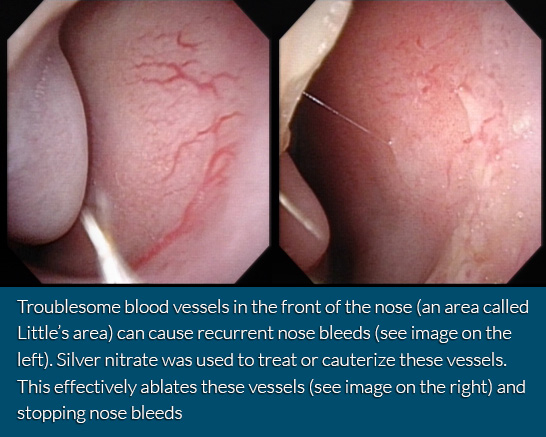
Radiofrequency Turbinate Reduction
Hypertrophy (enlargement) of the nasal turbinates is a common cause of nasal blockage or congestion. This often causes a blocked nose which is worst at night and disrupts sleep. This nasal blockage is often not relieved by the use of nasal steroid sprays. Reduction of the nasal turbinates may then be necessary. Radiofrequency Turbinate Reduction or Radiofrequency Inferior Turbinoplasty (RFIT) is a common procedure that can be undertaken in clinic with simple local anaesthesia. This is a pain-free procedure that can be completed in approximately 20 minutes.
The procedure is a day surgery procedure and is reimbursed by most major insurers and medisave.
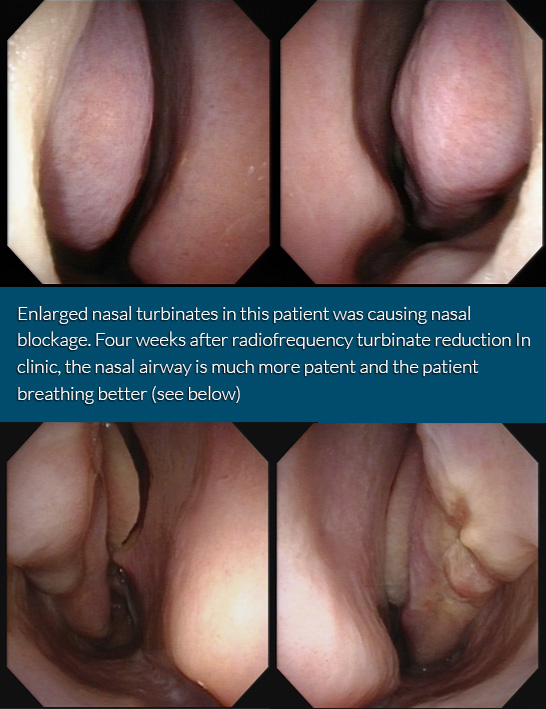
Excision of small “lumps and bumps”
Many oral cavity, tongue and lip lesions can be effectively removed and treated in our clinic’s treatment room. We can also undertake surgical removal of lesions of the skin and earlobe under local anaesthesia. Simple lacerations can be sutured and repaired quickly without the need to be admitted and visit the operating theatre.
Ultrasound & Fine Needle Aspiration Cytology
Our clinic in Novena has a bedside ultrasound machine which allows for us to undertake ultrasound assessment of neck lesions, lymph nodes, the thyroid and salivary glands. Ultrasound is a useful adjunct to the examination of the neck. Ultrasound allows for the comprehensive assessment of the thyroid gland. It can help characterize thyroid nodules and thyroid cysts. It is useful in the assessment of thyroiditis, multinodular goitres and thyroid cancers. It can also help identify parathyroid adenomas which are enlarged parathyroid glands.
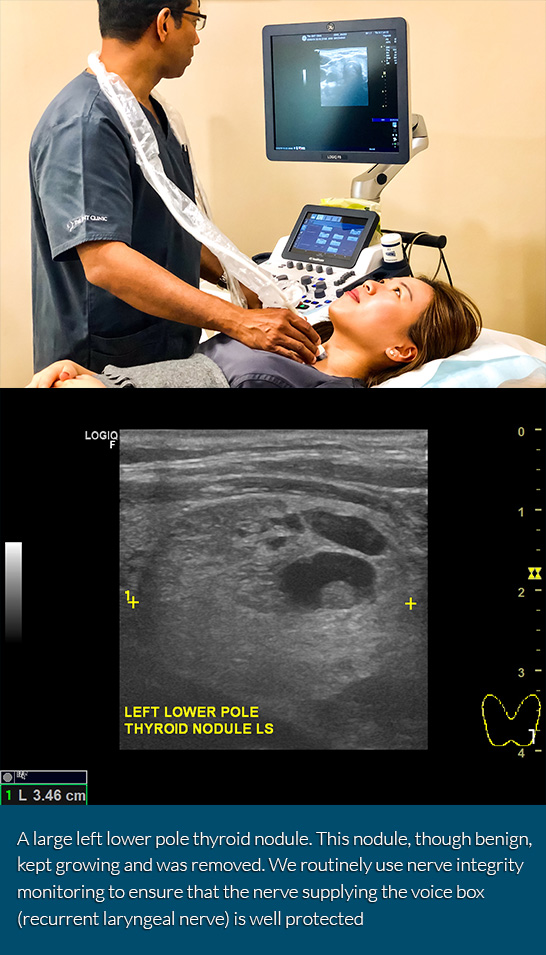
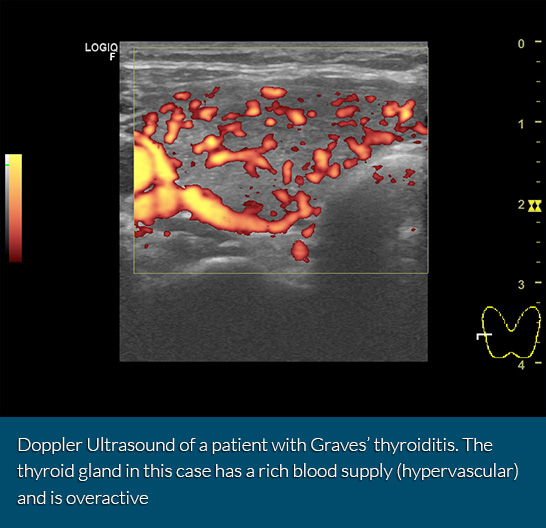
Enlarged lymph nodes of the neck are a common cause of alarm amongst patients. These lymph nodes may be enlarged due to an infection or more serious conditions such as lymphoma or cancers of the head and neck. Infections such as tuberculosis (TB), atypical mycobacteria, bartonella (cat scratch fever) or histoplasmosis may cause persistent enlargement of cervical (neck) lymph nodes. Often abnormal lymph nodes have characteristic features on ultrasound and help us decide on correct management.
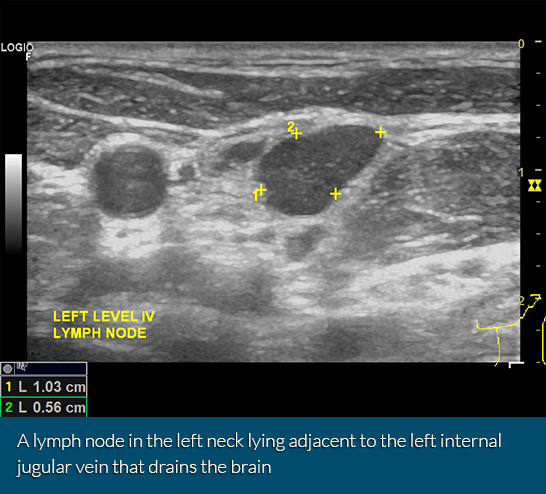
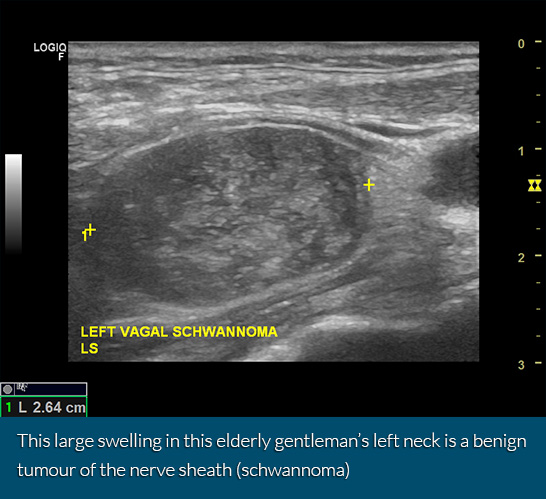
Ultrasound is extremely useful in the assessment of salivary glands. Both the submandibular and parotid salivary glands are amenable to simple ultrasound assessment. Tumours of the salivary gland, salivary gland stones and inflammation of the salivary gland (sialadenitis) are easily identified with ultrasonography.
Ultrasound guided fine needle biopsy (FNAC) can be undertaken in the clinic. This allows for more accurate sampling of thyroid nodules, tumours of the salivary gland and abnormal lymph nodes. This procedure can be undertaken with simple local anaesthesia. A fine needle is used to sample cells from any suspicious thyroid nodules, salivary gland lesions or enlarged lymph nodes. The fluid aspirated (drawn) from these lesions is then smeared on a glass slide and submitted for cytology. Fine needle aspiration cytology (FNAC) is a highly accurate way of diagnosing neck lumps. It is safe and does not cause the dissemination (or spread) of cancer cells.
FNAC is a procedure reimbursed by major insurers and Medisave.



